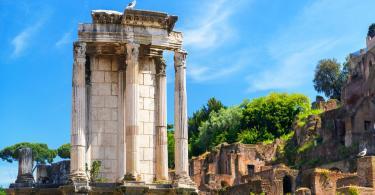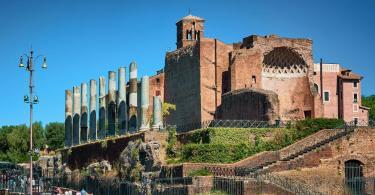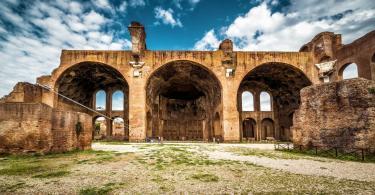The Temple of Vesta, which is among the earliest in Rome, is positioned to the south of the Via...
Category - Roman Forum
A trip to Rome is not complete without a visit to the Roman Forum. This is where the fate of Europe was decided for centuries; for a millennium the might of the Roman Empire and the beauty of art, Roman law and ancient religious beliefs were expressed here in an overwhelming style.
This was the political, administrative, and religious centre of Rome in the days of the kings and the Republic. Around the triumphal Via Sacra, where generals paraded after successful campaigns, were ranged the city’s most important monuments: the Forum and the home of the senate – the Curia – as well as a plethora of temples, basilicas, and triumphal arches. In the beginning, however, the locality was hardly hospitable: it was a marsh which also served as a burial ground. In the sixth century BC the Etruscan king Tarquin the Elder (ca. 616- ca. 578 BC) drained the water into the Tiber, and the plain soon became the site of the city’s first forum.
The advent of the Republic witnessed the addition of further buildings, shops, and of course temples: one dedicated to Saturn, another to Castor and Pollux. The forum underwent continual facelifts, notably when it was lined with colonnades in the second century BC. At this time, work began on the Basilica Aemilia and the Basilica Julia, vast roofed structures divided into several ‘naves’ and used to transact all kinds of business. None the less, they could not compensate for the restricted size of the forum or satisfy the requirements of a million or so inhabitants. Activity then began to extend towards the Campus Martius, in the area around the Pantheon, and, a little further north, to the new imperial forums. By depriving it of its essential functions, the emperors were to transform the heart of Rome’s economic power into a stage for their own glorification. They accelerated this change by adding commemorative or religious monuments. Augustus (27 BC-AD 14), Titus (79-81), and Septimius Severus (193-211) raised triumphal arches; Antoninus Pius (138-161), Maxentius (306-312), and Constantine (312-337) built new temples.
Today, an air of desolation broods over the ruin-strewn wasteland that was the Forum Romanum. Here and there emerge the elegant Corinthian columns of the Temple of Castor and Pollux, part of a colonnade, and the series of statues which graced the House of the Vestals (Atrium Vestae). Further off, the arcades of the Basilica of Maxentius and Constantine bear witness to the last flowering of an empire in decline.
The most evocative ruins are the triumphal arches on either side of the Via Sacra. Near the brick building which housed the Curia, that of Septimius Severus (203 AD) is remarkable for its extravagant decoration, while the slender first- century Arch of Titus still seems to be watching over the ‘grandeur that was Rome’.
The most significant buildings are described below.
Temple of Venus and Roma
On the imposing artificial base that still appears on the west side of the valley of the Colosseum...
Arch of Titus
The Arch of Titus commands a vantage point at the highest space of the Sacred Way. It oversees the...
Basilica of Maxentius
An architectural masterpiece standing proudly in the heart of Rome, the Basilica of Maxentius and...




